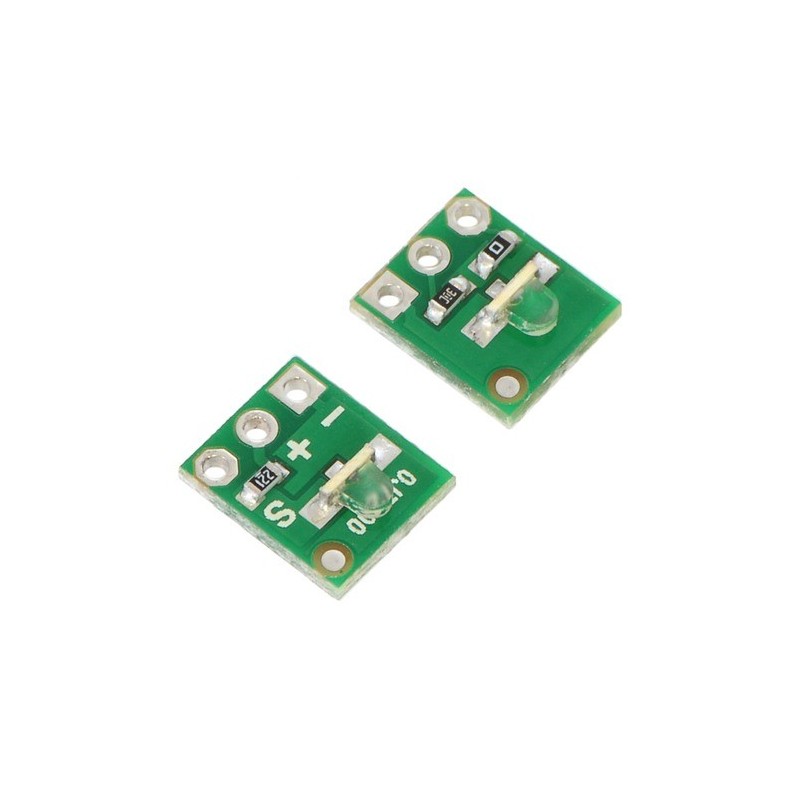

The QTR-L-1A reflectance sensor incorporates a right-angle infrared LED and a right-angle phototransistor in an inexpensive, tiny 0.35" A— 0.3" module that can be mounted almost anywhere and is great for edge detection and line following. The reflectance measurement is output as an analog voltage. This sensor is sold in packs of two units.
Note: The QTR-L-1A reflectance sensor requires an analog input to take readings. The similar QTR-L-1RC reflectance sensor is available with a digital I/O-compatible output.
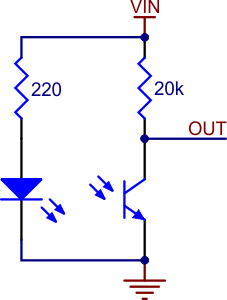 |
The Pololu QTR-L-1A reflectance sensor carries a right-angle infrared LED and a right-angle phototransistor, both pointing toward the front edge of the board. The phototransistor is connected to a pull-up resistor to form a voltage divider that produces an analog voltage output between 0 V and VIN (which is typically 5 V) as a function of the reflected IR. Lower output voltage is an indication of greater reflection.
The LED current-limiting resistor is set to deliver approximately 17 mA to the LED when VIN is 5 V. The current requirement can be met by some microcontroller I/O lines, allowing the sensor to be powered up and down through an I/O line to conserve power.
This sensor was designed to be used with the board perpendicular to the surface being sensed, and narrow-angle lenses built into the infrared LED and phototransistor packages allow it to be effective to a range of about 1" (25 mm). Because of its small size, multiple units can easily be arranged to fit various applications such as line sensing and proximity/edge detection. The QTR-L-1A is sold in packs of two units.
For a similar sensor that can be used with the board parallel to the surface, but with shorter range, please see the QTR-1A reflectance sensor. We also offer arrays of three and eight sensors: the QTR-3A reflectance sensor array and the QTR-8A reflectance sensor array.
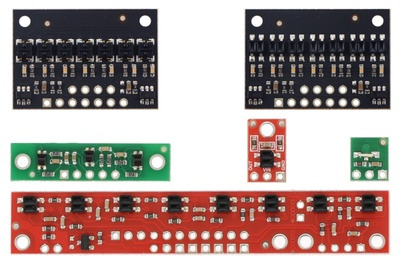 |
| QTR sensor size comparison. Clockwise from top left: QTR-3RC, QTR-1RC, QTR-L-1RC, QTR-8RC. |
|---|
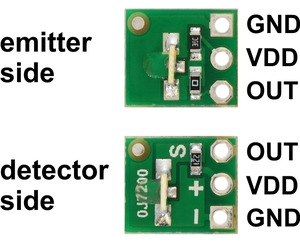 |
There are several ways you can interface with the QTR-L-1A output:
This last method will work if you are able to get high reflectance from your white surface (so that there is a large output voltage difference over black and white surfaces), but will probably fail if you have a lower-reflectance signal profile. The following table shows some typical output voltages from the sensor over different surfaces and at different distances:
| White surface | 3/4" black electrical tape | |
|---|---|---|
| 0.25" distance | 0.2 V | 3.8 V |
| 1" distance | 2.4 V | 3.5 V |
Ambient light, especially sunlight, can affect the sensor readings significantly. If the output voltage from the QTR-L-1A is consistently low, you might need to add shielding around the sensor or mount it in a different location to reduce interference from outside light sources.
Our Pololu AVR library provides functions that make it easy to use these sensors with our Orangutan robot controllers; please see the QTR Reflectance Sensors section of our library command reference for more information. We also have a Arduino library for these sensors.
Each pack of two reflectance sensors includes sets of straight male header strips and right-angle male header strips, which allow you to mount them in the orientation of your choice. You can also solder wires, such as ribbon cable, directly to the pads for the most compact installation.
|
|
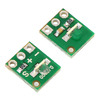 |
QTR-L-1RC Reflectance Sensor (2-Pack) |
 |
QTR-1A Reflectance Sensor |
 |
Sharp GP2Y0A21YK0F Analog Distance Sensor 10-80cm |
Manufacturer BTC Korporacja sp. z o. o. Lwowska 5 05-120 Legionowo Poland sprzedaz@kamami.pl 22 767 36 20
Responsible person BTC Korporacja sp. z o. o. Lwowska 5 05-120 Legionowo Poland sprzedaz@kamami.pl 22 767 36 20
No product available!
The module allows the measurement of lighting in the vicinity of the sensor. The measuring range is from 1 to 65535 LUX, and communication takes place using the I2C bus. DFRobot SEN0097
Module with an ambient light sensor VEML6030 with a measuring range up to 120,000 lx. It enables light measurement with 16-bit resolution. I2C communication. SparkFun SEN-15436
Module with color sensor TCS3472. The board is equipped with a Grove connector and communicates via the I2C interface. M5Stack U009
Module with light intensity sensor TSL2591. Equipped with STEMMA QT connector with I2C interface. Adafruit 1980
Module with light sensor VEML7700. It allows you to measure the intensity in the range from 0 to 120 Klx. Equipped with a STEMMA QT connector, it communicates via the I2C interface. Adafruit 5378
Module with light sensor - LS06-S phototransistor. The board is equipped with a Grove connector and has an analog output. Seeed Studio 101020132
Precision XYZ color and light sensor with I2C interface. Measures light intensity and color components, features STEMMA QT / Qwiic connectors. Adafruit 6335
Module with a SI1151 light sensor that can detect waves with a wide range of wavelengths: visible and infrared light. The board is equipped with a Grove connector and communicates via the I2C interface. Seeed Studio 101020089
No product available!
Module with an analog TEMT6000 light intensity sensor. The voltage at the output is linearly correlated with the intensity of the incident light. The module is supplied with the voltage from 3.3 to 5V. DFRobot SEN0043
Module with a flame sensor or other light sources with a wavelength in the range of 760 to 1100 nm. It was based on the YG1006 sensor (photovolver NPN). The sensor has a connector compatible with the Grove standard. Seeed studio 101020049
Crowtail – Flame Sensor 2.0 is a module detecting infrared radiation and flame sources, operating in the range of 760–1100 nm. Intended for use in safety systems, robotics, and educational projects.
Module with an analog TEMT6000 light intensity sensor. The output voltage increases with increasing intensity of the incident light. The sensor is powered by 5 V. SparkFun BOB-08688
No product available!
Multi-functional environmental sensor consisting of SHTC3 temperature and humidity sensor, BMP280 pressure sensor, VEML7700 ambient light sensor and ML8511 UV sensor. DFRobot SEN0500
This sensor is a carrier/breakout board for ST’s VL6180X proximity and ambient light sensor, which measures the range to a target object up to 20 cm away (or 60 cm with reduced resolution). Pololu 2489
Module with an integrated proximity and ambient light sensor based on the VCNL4040 system. It can detect obstacles in the range of 0 to 20 cm. It communicates via the I2C bus. Adafruit 4161

